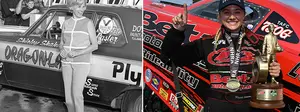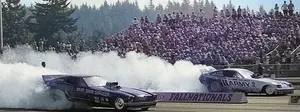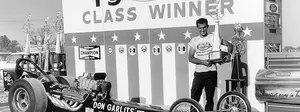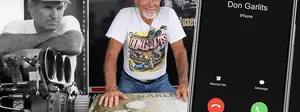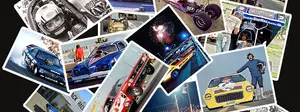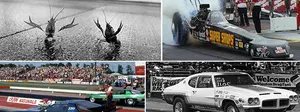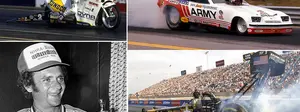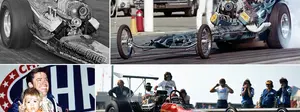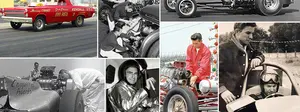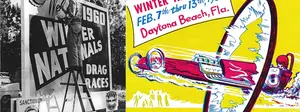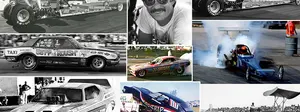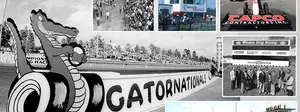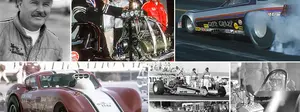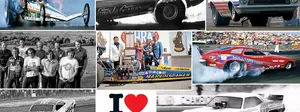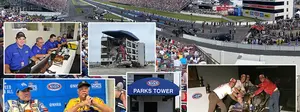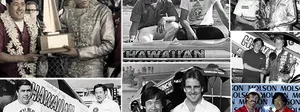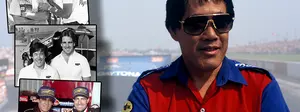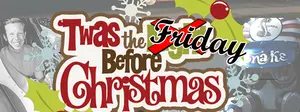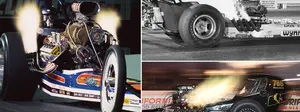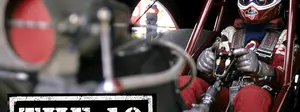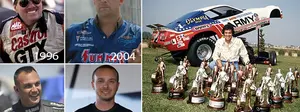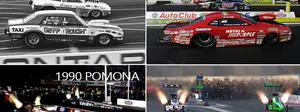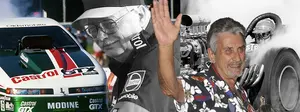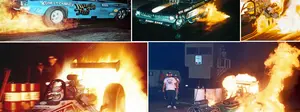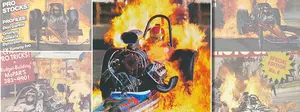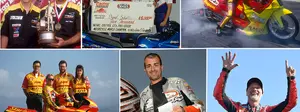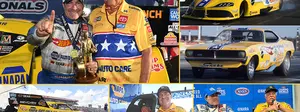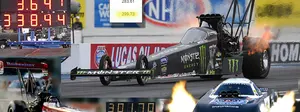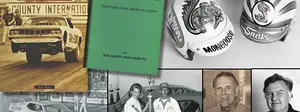Simply terrifying
 |
 |
 |
 |
 |
 |
After it was mentioned in a couple of the Southern California-based First Race stories, I got a few inquiries for more details about John Smyser’s Terrifying Toronado exhibition car, which, terrifyingly enough, is best remembered for hurtling the guardrail at Irwindale Raceway and scaring the bejesus out of the fans in that section.
By all accounts, Smyser was a very good Top Fuel racer. With Nando Haase driving, his 392 Chrysler-powered Radar Wheels entry won the 1965 Hot Rod Magazine Championships in Riverside, Calif., and he and Harry Hibler were runner-up to Tony Nancy at the 1970 March Meet.
The Terrifying Toronado had its street roots in Olds’ peculiar attempt at a muscle car. With gobs of horsepower under the hood and chain-driven front-wheel drive for better traction, it should have been a huge winner, right? After all, while the GTOs and Mustangs were melting the hides trying to glue their tires to the road, the Olds would hook up just fine, thank you very much. The car was so highly praised that it won Motor Trend’s prestigious Car of the Year award in 1966. Smyser’s car was a ’66 – the first year in a production that ran through 1992 – and shared the same engine as the production car, a 425-cid V-8 powerplant.
Noted speed merchant Don Ratican (of Ratican-Jackson-Stearns fame) built the two Olds engines that, while they retained the stock displacement, were pretty racy, packed with Mickey Thompson pistons with Grant rings, a Racer Brown camshaft, heads ported and polished by Valley Head Service, and, naturally, a 6-71 supercharger.
The front engine turned the front 10-inch-wide Casler slicks on Halibrand wheels through the conventional Toronado automatic transmission and differential while the rear-seat-mounted second engine used a dual-disc clutch and a Schiefer aluminum flywheel to funnel power via direct drive to a conventional Olds rear end.
While the wheelbase remained at the stock 119 inches, the track was widened 8 1/2 inches in front and 2 1/2 inches in the rear, presumably for stability and tire clearance. The rear engine sat in a subframe that was easily removable for repairs (maybe they knew something ahead of time?). The car tipped the scales at a portly 4,500 pounds.
Despite its pedigree, the car may have been one of the more ill-conceived and certainly most ill-handling race cars ever built. Or maybe it was just too far ahead of its time.
The Terrifying Toronado was unveiled at the 1966 AHRA Winternationals at Irwindale and made its first run the following week at the ‘Dale. On its fateful lone pass, Smyser lost the handle early, with the car first darting left for the centerline, then hooking up hard and plunging back to the right into and over the Armco. As the famous photos show, it didn’t make it much farther than the guardrail and fell comfortably short – easy for me to say because I wasn’t sitting in the stands – of the chain-link fence.
It ran a few other times that year but never performed well enough to merit much attention. The car’s final outing came about a year after its debut, at the 1967 NHRA Winternationals in Pomona, where the car again ran afoul of the laws of physics. During Saturday qualifying, Smyser made an exhibition pass but again the car got all terrifying on him and busted through the right-side guardrail at speed at three-quarter-track. Fortunately, there were no grandstands that far downtrack. Regardless, it became clear that the Terrifying Toronado was just too terrifying to continue, and the car was retired.
 |
Of course, that’s only half the story because the Terrifying Toronado had a cousin from the other side of the country in the Hurst Hairy Olds. Built in a similar fashion for the 1966 season, the car (an Olds 442) reportedly was built to showcase the bulletproof qualities of the then-new chain-driven automatic transaxle of the '66 Toronado, which had its skeptics in the automotive press. After all, if it could harness the power of a supercharged engine, it should do well in stock configuration, right? (Truth be told, although the front drivetrain was essentially stock, the right-hand axleshafts were swapped for left-hand units because they were stronger, and the torque converters were beefed up, but those are minor points.)
George Hurst, wanting a companion to the wildly popular Hemi Under Glass wheelstander, signed on to the project. The tube-frame car was built in-house at Hurst under the watchful eye of Jack “Shifty Doctor” Watson, president of Hurst Performance Research. Although the car went on a diet thanks to aluminum body components (floor, inner fender panels, wheelwells, hood, interior panels, deck lid, and bumpers) and Plexiglas windows, it still weighed in excess of 4,000 pounds. Despite the hefty weight, the car suffered – as almost all front drivers do – from torque steer, making it a thrill to drive and watch as it smoked all four M&H slicks down the dragstrip. Top Fuel and Top Gas racer Joe Schubeck drove the car in its debut at the 1966 March Meet and later ran in the 11-second range.
 |
The first version of the Hairy Olds ran off the end of a track and into a farmer’s field in 1966, and Schubeck broke an ankle bailing out of the out-of-control dreadnought. Although the car suffered significant damage, it was rebuilt and eventually ran into the low eights at more than 180 mph. It, too, end up in a ball at Niagara Dragstrip in New York in 1967.
According to the report, “the magneto on the front engine quit. This, of course, cut all power to the front end, allowing the alignment to revert back to the toe-out setting, which was not conducive to good handling. The car went off the track onto wet grass and headed toward the spectators who gathered against the fence. As they cheered Joe's performance, the crowd had no idea of the real danger they were in. Only a cable stretched down the length of the track kept the situation from getting ugly. Shortly afterward, the crew took the car back to ‘Doc’ Watson at Hurst and turned it in. From all accounts, Watson cut it up and buried it, save for the aluminum bumpers and hood,” which were used in a re-creation of the car.
Although Tommy Ivo had proven as early as 1961 that an all-wheel car could work well, the design of Ivo’s four-engine Showboat – with the left engines powering the front tires and the right side powering the rear – gave it the stability that the Terrifying Toronado and the Hurst Hairy Olds never had and undoubtedly led to its impressive longevity and popularity.


